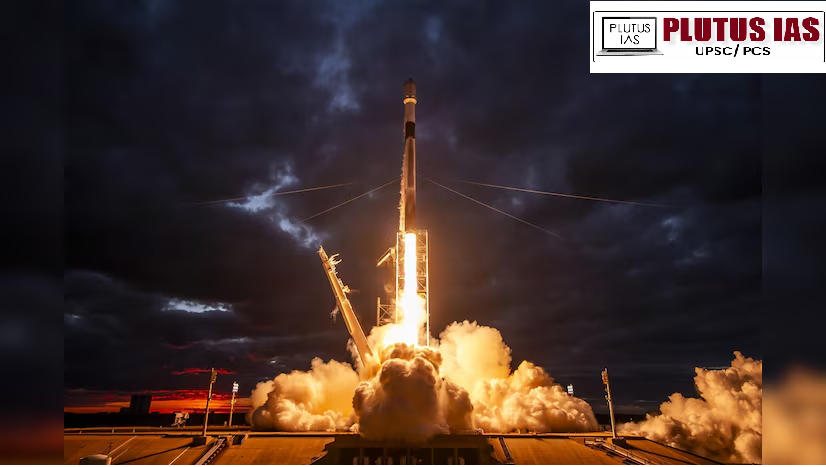03 Jan India Targets Space Docking Milestone with ISRO’s SpaDeX Mission
SYLLABUS MAPPING:
GS-3-Science and Technology-India Targets Space Docking Milestone with ISRO’s SpaDeX Mission
FOR PRELIMS:
What is SpaDeX experiments various navigation systems of different countries
FOR MAINS
What are space docking and its significance, and challenges are associated with it
Why in the news?
Space docking is a complex process where two spacecraft connect in orbit, either automatically or manually, for tasks like crew transfer or resupply.
1. Rendezvous: One spacecraft (the chaser) adjusts its orbit to approach the target spacecraft, matching speed and position for alignment.
2. Approach: The chaser fine-tunes its position to get close to the target (usually within 10-50 meters), using onboard sensors for navigation.
3. Docking:
Automated Docking: Systems like the Kurs or IDSS guide the spacecraft into the docking port using sensors, lasers, and cameras.
Manual Docking: Crew manually controls the approach using thrusters and cameras, a technique used in early missions.
4. Latching: The docking mechanisms engage, securing the spacecraft together. Pressure equalization and sealing ensure safety.
5. Post-Docking: Systems are checked for secure connections and communication links. Crew or cargo may transfer between spacecraft.
6. Undocking: If needed, spacecraft disengage using thrusters and safely separate.
Significance of the space docking:
1. Crew Transfer: Docking allows astronauts to move between spacecraft, such as from the SpaceX Dragon or Soyuz to the International Space Station (ISS), supporting long-duration missions.
2. Resupply and Maintenance: Docking facilitates the delivery of cargo, scientific equipment, and fuel to space stations, such as the ISS, enabling ongoing research and station upkeep.
3. International Collaboration: It enables countries to work together in space, as seen in the Apollo-Soyuz Test Project and the ISS, where spacecraft from different nations dock for joint missions.
4. Scientific Research: Docking enables the transfer of crew and equipment to space labs, allowing for continuous scientific experiments and space station operations.
5. Support for Deep-Space Exploration: For future missions to the Moon, Mars, or beyond, docking will be critical for assembling spacecraft, transferring supplies and crew, and ensuring mission success.
6. Automated Systems and Safety: With automated docking systems, space missions become more efficient, reducing the need for manual labour and improving safety during docking operations.
Challenges in space docking:
1. Precision and Navigation: Docking requires extremely precise maneuvering. Even slight misalignments can cause failure, so accurate navigation, guidance, and control systems are essential to ensure safe docking.
2. Relative Motion: Spacecraft must approach each other in orbit while moving at high speeds (up to 28,000 km/h). Small errors in speed or trajectory can lead to a collision or missed docking.
Automated docking systems rely on advanced sensors (such as cameras, radar, and lasers) to guide spa
3. Automation and Sensors:cecraft into place. These sensors must function flawlessly in the absence of atmospheric reference points and handle potential interference or failures.
4. Mechanical Compatibility: Different spacecraft may use different docking mechanisms. Ensuring compatibility between spacecraft, such as between the Russian Soyuz and American spacecraft, requires custom adapters or universal standards like the International Docking System Standard (IDSS).
5. Pressure Sealing: After docking, ensuring airtight seals is critical for crew safety. Any failure in the docking ring or seals can lead to leaks, compromising the pressure inside the spacecraft.
6. Environmental Hazards: Spacecraft must account for various space hazards, including micrometeoroids, space debris, and radiation. These factors can pose risks to the docking process and equipment integrity.
7. Crew Coordination: In manual docking, astronauts must rely on visual cues and instruments to safely guide the spacecraft into position, requiring high skill and coordination, especially in challenging conditions like low-light or zero gravity.
Ways to carried out space docking in a proper manner:
1. Precise Rendezvous: Accurate calculations and continuous monitoring of position and speed ensure a safe approach.
2. Advanced Navigation: Automated docking systems use sensors (radar, lidar, cameras) to guide spacecraft, with manual control as a backup.
3. Docking Compatibility: Standardized systems like IDSS ensure spacecraft from different nations can dock seamlessly.
4. Sensor Integration: High-precision sensors enable accurate final alignment for safe docking, accounting for space environment factors.
5. Controlled Approach: Spacecraft approach at low speeds with finely tuned thrusters to prevent damage.
6. Pressure Integrity: Secure, airtight seals are ensured using locking mechanisms and leak testing post-docking.
7. Communication: Continuous communication between spacecraft and crew ensures coordinated manoeuvres.
Conclusion
The SpaDeX mission marks a major technological achievement for India. By mastering space docking, ISRO will not only enhance its capability to carry out satellite servicing and interplanetary exploration but also strengthen its role in global space missions. The advancements demonstrated in this mission will be foundational for India’s future space exploration endeavours, ensuring long-term sustainability and growth in space activities.
Download Plutus IAS Current Affairs (Eng) 03rd Jan 2025
Prelims Question:
2. The SpaDeX mission involves two large spacecraft, each weighing over 500 kg.
3. The docking technology used in the SpaDeX mission is the Bharatiya Docking System (BDS), developed indigenously by ISRO.
A. Only one
B. Only two
C. All three
D. None
Answer: A
Mains Question:
(250 words, 15 marks)





No Comments